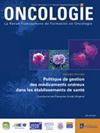Catalase expression is an independent prognostic marker in liver hepatocellular carcinoma
IF 2.5
4区 医学
Q4 ONCOLOGY
引用次数: 0
Abstract
Abstract Objectives Liver hepatocellular carcinoma (LIHC) is the most common type of primary liver cancer and originates from hepatocytes, the main functional cells of the liver. It is a serious and aggressive cancer with a generally poor prognosis, especially when diagnosed at advanced stages. Reactive oxygen species (ROS) have been detected in LIHC and are involved in carcinogenesis and tumor progression. Here, a comprehensive analysis was performed to evaluate the effects of ROS-related genes on the prognosis of LIHC. Methods Using bioinformatical tools including Gene Expression Profiling Interactive Analysis (GEPIA2) and Q-omics, a comprehensive analysis was performed to evaluate the effects of ROS-related genes, including superoxide dismutases (SODs), glutathione peroxidases (GPXs), peroxiredoxins (PRDXs) and catalase (CAT) on the prognosis of LIHC using The Cancer Genome Atlas (TCGA) dataset and identified the most appropriate candidate genes. Then we further explored their effects on LIHC cell proliferation and drug selection for LIHC treatment. Results We found that CAT expression was significantly downregulated in late stage’s LIHC tissues compared to normal liver or early stage’s LIHC tissues, and high CAT expression was correlated with a favorable survival prognosis in LIHC. The expression of the CAT gene was associated with an inhibition of the “cell cycle” pathway. HepG2 and Hep3B cells’ growth was increased with a decrease in CAT expression by silencing its mRNA. As silencing of CAT in HepG2 and Hep3B cells, and its association with an increase in the expression of PLK1, CCNB1, CDC20, and PTTG1. A comparative 426 drug response in LIHC cells with different CAT expression, SU11274, a Met inhibitor, could serve as a therapeutic option when CAT levels are low in LIHC cells. Conclusions Our findings revealed that Met inhibitors could potentially control tumor progression and be used as a therapeutic option against LIHC with low CAT.过氧化氢酶的表达是肝脏肝细胞癌的独立预后指标
摘要 目的 肝肝细胞癌(LIHC)是原发性肝癌中最常见的一种,起源于肝脏的主要功能细胞--肝细胞。它是一种严重的侵袭性癌症,预后普遍较差,尤其是在晚期确诊时。在 LIHC 中检测到了活性氧(ROS),它参与了癌变和肿瘤进展。在此,我们进行了一项综合分析,以评估 ROS 相关基因对 LIHC 预后的影响。方法 利用基因表达谱交互分析(GEPIA2)和Q-omics等生物信息学工具,通过癌症基因组图谱(TCGA)数据集,对ROS相关基因(包括超氧化物歧化酶(SOD)、谷胱甘肽过氧化物酶(GPX)、过氧化还原酶(PRDX)和过氧化氢酶(CAT))对LIHC预后的影响进行了全面分析,并确定了最合适的候选基因。然后,我们进一步探讨了它们对 LIHC 细胞增殖和治疗 LIHC 药物选择的影响。结果 我们发现,与正常肝脏或早期LIHC组织相比,CAT在晚期LIHC组织中的表达明显下调,CAT的高表达与LIHC的良好生存预后相关。CAT 基因的表达与 "细胞周期 "途径的抑制有关。通过沉默 CAT 的 mRNA,HepG2 和 Hep3B 细胞的生长随着 CAT 表达的减少而增加。由于 HepG2 和 Hep3B 细胞中 CAT 的沉默及其与 PLK1、CCNB1、CDC20 和 PTTG1 表达的增加有关。通过比较不同 CAT 表达的 LIHC 细胞对 426 药物的反应,当 LIHC 细胞中 CAT 水平较低时,Met 抑制剂 SU11274 可作为一种治疗选择。结论 我们的研究结果表明,Met 抑制剂有可能控制肿瘤进展,并可作为一种治疗 CAT 低的 LIHC 的选择。
本文章由计算机程序翻译,如有差异,请以英文原文为准。
求助全文
约1分钟内获得全文
求助全文
来源期刊

Oncologie
医学-肿瘤学
CiteScore
1.30
自引率
11.10%
发文量
32
审稿时长
6-12 weeks
期刊介绍:
Oncologie is aimed to the publication of high quality original research articles, review papers, case report, etc. with an active interest in vivo or vitro study of cancer biology. Study relating to the pathology, diagnosis, and advanced treatment of all types of cancers, as well as research from any of the disciplines related to this field of interest. The journal has English and French bilingual publication.
 求助内容:
求助内容: 应助结果提醒方式:
应助结果提醒方式:


